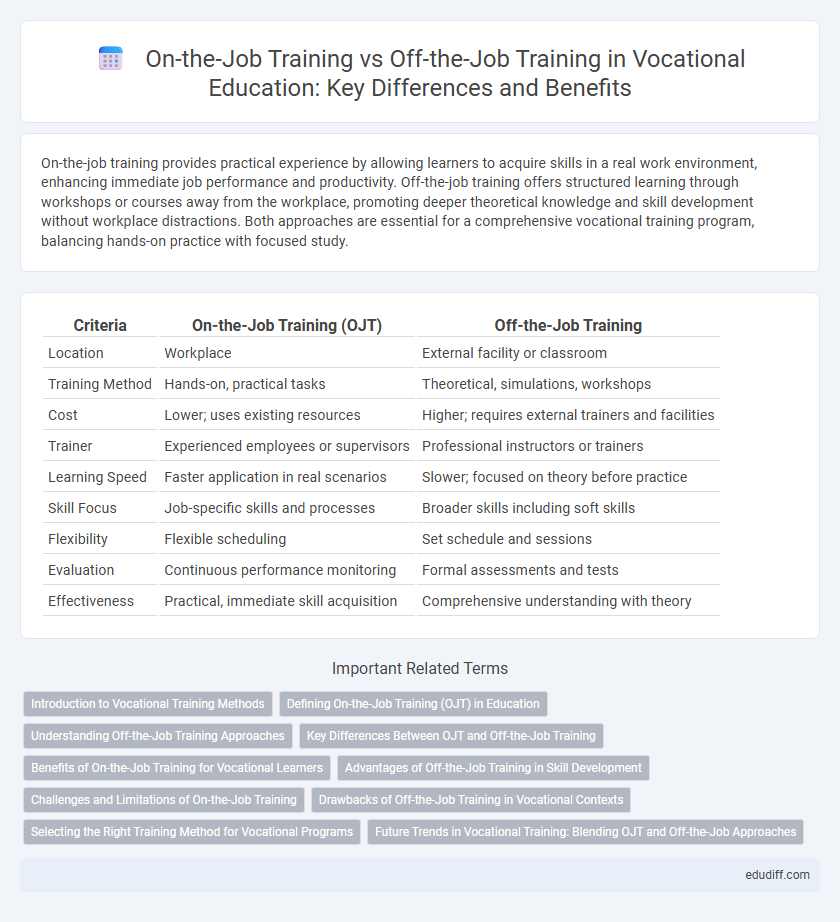On-the-job training provides practical experience by allowing learners to acquire skills in a real work environment, enhancing immediate job performance and productivity. Off-the-job training offers structured learning through workshops or courses away from the workplace, promoting deeper theoretical knowledge and skill development without workplace distractions. Both approaches are essential for a comprehensive vocational training program, balancing hands-on practice with focused study.
Table of Comparison
| Criteria | On-the-Job Training (OJT) | Off-the-Job Training |
|---|---|---|
| Location | Workplace | External facility or classroom |
| Training Method | Hands-on, practical tasks | Theoretical, simulations, workshops |
| Cost | Lower; uses existing resources | Higher; requires external trainers and facilities |
| Trainer | Experienced employees or supervisors | Professional instructors or trainers |
| Learning Speed | Faster application in real scenarios | Slower; focused on theory before practice |
| Skill Focus | Job-specific skills and processes | Broader skills including soft skills |
| Flexibility | Flexible scheduling | Set schedule and sessions |
| Evaluation | Continuous performance monitoring | Formal assessments and tests |
| Effectiveness | Practical, immediate skill acquisition | Comprehensive understanding with theory |
Introduction to Vocational Training Methods
On-the-Job Training (OJT) immerses trainees directly in the workplace, enhancing hands-on skills through real-life tasks and immediate feedback, which accelerates practical learning efficiency. Off-the-Job Training (Off-JT) emphasizes theoretical knowledge and skill development in controlled environments such as workshops or classrooms, promoting deep understanding and broadening vocational competencies. Combining OJT and Off-JT creates a comprehensive vocational training approach that balances experiential learning with structured education for optimal skill acquisition.
Defining On-the-Job Training (OJT) in Education
On-the-Job Training (OJT) in education refers to practical learning conducted within the actual work environment, allowing students or trainees to acquire hands-on experience alongside experienced professionals. This method enhances skill development through real-time application of theoretical knowledge and immediate feedback. OJT is essential in vocational education as it bridges the gap between classroom instruction and workplace demands.
Understanding Off-the-Job Training Approaches
Off-the-job training approaches include classroom lectures, workshops, simulations, and e-learning modules designed to develop theoretical knowledge and practical skills away from the work environment. These methods allow employees to focus on learning without workplace distractions, fostering deeper understanding and skill acquisition. Off-the-job training is especially effective for complex skill development, soft skills enhancement, and compliance training.
Key Differences Between OJT and Off-the-Job Training
On-the-Job Training (OJT) involves practical, hands-on experience at the workplace, allowing trainees to learn tasks in real-time under supervision, which enhances immediate skill application and productivity. Off-the-Job Training occurs outside the usual work environment, often in classrooms or workshops, focusing on theoretical knowledge and structured learning without the pressures of daily work duties. Key differences include the learning setting, with OJT providing contextual, job-specific experience, while off-the-job training offers a broader, more formal education that can encompass soft skills and advanced concepts beyond immediate job tasks.
Benefits of On-the-Job Training for Vocational Learners
On-the-job training enhances vocational learners' practical skills by providing real-time experience within the actual work environment, leading to higher retention and immediate application of knowledge. This method fosters direct mentorship from experienced professionals, promoting tailored feedback and skill refinement critical for vocational mastery. Cost-effective and aligned with industry standards, on-the-job training accelerates employability and career readiness for vocational students.
Advantages of Off-the-Job Training in Skill Development
Off-the-job training offers a structured learning environment that allows employees to focus entirely on skill acquisition without workplace distractions. It provides access to expert instructors, advanced resources, and diverse learning methods, accelerating professional development. This form of training encourages innovation and critical thinking by exposing learners to broader concepts beyond immediate job tasks.
Challenges and Limitations of On-the-Job Training
On-the-Job Training (OJT) faces challenges such as inconsistent training quality due to varying instructor expertise and potential distractions from daily work tasks that can hinder learning effectiveness. Limited availability of skilled mentors and the risk of operational errors during training also pose significant drawbacks. Furthermore, OJT may not cover theoretical knowledge comprehensively, restricting the trainee's understanding of complex concepts needed for advanced job performance.
Drawbacks of Off-the-Job Training in Vocational Contexts
Off-the-job training in vocational settings often lacks immediate applicability, leading to gaps between learned theories and practical skills needed on the job. This type of training can be costly for organizations due to expenses for facilities, trainers, and time away from work. Trainees may also experience reduced motivation and engagement without the real-time feedback and contextual relevance present in on-the-job training.
Selecting the Right Training Method for Vocational Programs
Choosing the right training method in vocational programs hinges on aligning learning objectives with practical application and resource availability. On-the-job training offers hands-on experience and immediate skill application, essential for trades requiring direct familiarity with tools and processes. Off-the-job training provides structured learning environments and access to expert instruction, beneficial for theoretical knowledge and developing broader competencies beyond immediate work tasks.
Future Trends in Vocational Training: Blending OJT and Off-the-Job Approaches
Future trends in vocational training emphasize the integration of On-the-Job Training (OJT) with Off-the-Job Training methodologies to create a comprehensive learning experience. Blending hands-on, practical skill development with structured theoretical instruction enhances adaptability and knowledge retention in dynamic industries. This hybrid approach leverages digital platforms and real-world applications, preparing trainees for evolving workforce demands and technological advancements.
On-the-Job Training vs Off-the-Job Training Infographic

 edudiff.com
edudiff.com